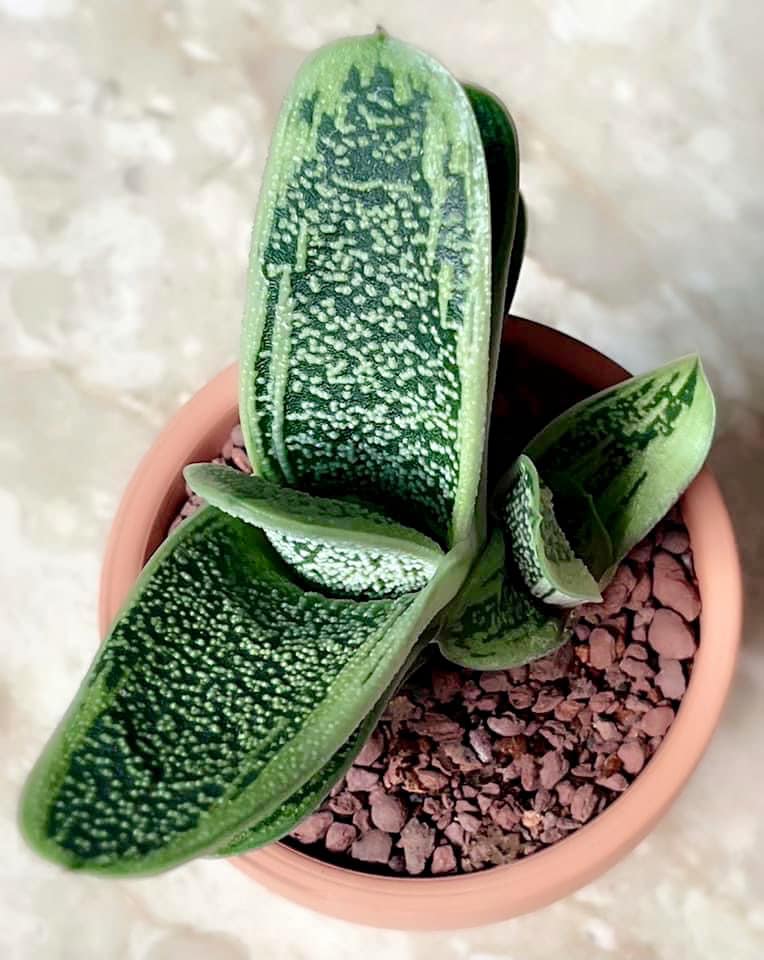✨🌱 The Textured Jewel of Succulents is Gasteria “Little Warty.”
The lovely, hardy succulent known as Gasteria ‘Little Warty’ is prized for its unique, textured leaves that have earned it the moniker “Little Warty.” This species, which is native to South Africa, is a hybrid cultivar of the Gasteria genus and is prized for its rough, bumpy leaf surface with stripes of green and white.
Because of its small size, minimal maintenance, and versatility, it is ideal for indoor gardening, desktops, and other small areas, especially for beginners or collectors seeking something distinctive but simple to maintain.
🌿 Introduction to Botany
Scientific Name: Gasteria “Little Warty”
Family: Asphodelaceae
Common Name: Small Warty Gasteria
Cultivar; parent species is native to South Africa.
Growth Pattern: Clumping, compact, and slow-growing
Size:
Height: 6-8 inches (15-20 cm)
Up to 10 inches (25 cm) in width over time.
🍃 Appearance
Leaves:
The leaves are thick, fleshy, and dark green.
has a rough, pebbly texture due to warts or tubercles covering it
Variegated with mottled patterns or light green streaks
The leaves are tongue-shaped and arranged in opposing pairs to create a fan-shaped rosette.
Flowers:
Creates tall, thin stems that bear flowers that are tubular and bell-shaped.
Flowers are usually coral or pinkish with green tips
sometimes blooms, usually from late spring through summer
Requirements for light
Within:
Favors brilliant, indirect lighting
Due to its higher tolerance for low to medium light levels, it is an excellent choice for indoor environments.
Leaves can be burned by prolonged exposure to direct sunshine, particularly in the afternoon.
Outdoors:
Ideal for filtered sunlight or shaded patios
Not frost-tolerant; bring inside if the temperature falls.
Tip: The plant may become elongated and lose its compact shape if there isn’t enough light.
The Temperature and Humidity
Temperature:
Best range: 18–26°C (65–79°F).
While it can withstand brief dips to 5°C (41°F), it favors warmer climates.
ideal for USDA hardiness zones 9–11
Humidity:
Flourishes in typical household humidity levels
Although low humidity is preferable, moderate moisture is acceptable if the air circulates well.
💧 Watering Schedule
From spring through autumn (active growth):
when the top two inches of soil have dried out, water it.
Typically, every 10–14 days, depending on the weather.
Water thoroughly, making sure the water drains, and never allow the plant to sit in water.
Winter (Dormancy):
Water less often, once every three to four weeks.
Let the soil dry out completely in between waterings
Root rot is most often caused by overwatering, especially in the winter.
Requirements for the soil
Kind:
requires a cactus or succulent mix that drains well
You are free to combine:
50% cactus potting mix
25% pumice or perlite
25% gravel or coarse sand
pH: Between mildly acidic and neutral (6.0–7.0)
Always use containers with drainage holes.
🌾 Manuring
Use fertilizers in the spring and summer:
Use a fertilizer that is either made for cacti and succulents or one that is well balanced and diluted.
Give food every four to six weeks.
There is no need for fertilization throughout the fall and winter.
✂️ Maintenance and Pruning
Low upkeep:
Get rid of any dried or dead leaves.
After blooming, trim away old flower stems
The health of plants can be maintained by sometimes dusting the leaves.
Propagation
Pups (Offsets):
At the base, it creates either pups or little offsets.
When they have a few roots, carefully divide and replant them.
Give the offset one to two days to callus over before replanting.
Leaf Cuttings:
Less common, yet feasible; before planting, cuttings should be allowed to callous.
Seeds: Not commonly cultivated because of their hybrid nature.
Offsets make propagation simple and efficient, allowing you to easily grow your collection.
🛡️ Typical Issues
Overwatering: Soft leaves, root rot
Wrinkled, shriveled leaves as a result of underwatering
Pests: typically resistant to pests, but sometimes:
mealybugs
Insects that live on scales
spider mites
Neem oil or insecticidal soap may be used to treat infestations.
⚠️ Toxicity
Safe for both animals and people
Suitable for households with kids and pets
🎍 For Decorative Purposes
Suitable for:
Desks or workplaces inside
Small containers or arrangements of succulents
Terrariums (open)
Outdoor shows with shade
Its distinctive texture, compact shape, and ability to thrive in low light make it a notable addition to any tiny area.
✅ Conclusion
The textured succulent Gasteria ‘Little Warty’ is simple to cultivate and adaptable to a variety of indoor environments. This lovely plant flourishes with minimal effort when provided with bright, indirect sunlight, careful watering, and a well-draining soil mixture. It provides year-round beauty and blooms from time to time.
Office Plants, Succulents
Gasteria Little Warty
₨599.00
Gasteria Little Warty
A quirky succulent with bumpy, textured leaves in rich greens—great for collectors and distinctive home decor.





Reviews
There are no reviews yet.